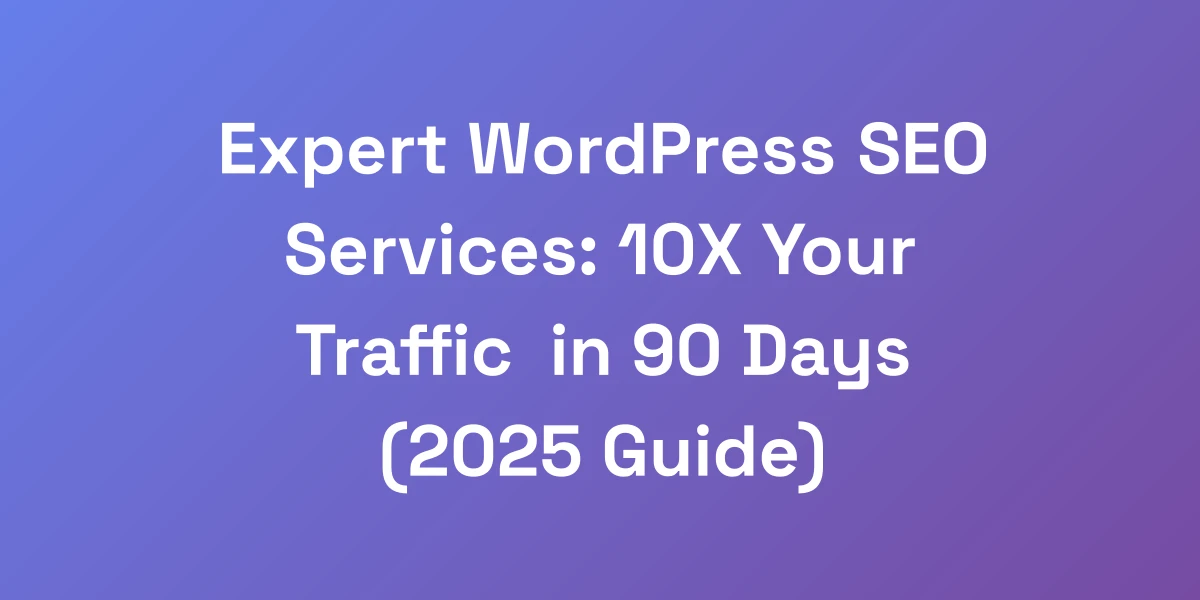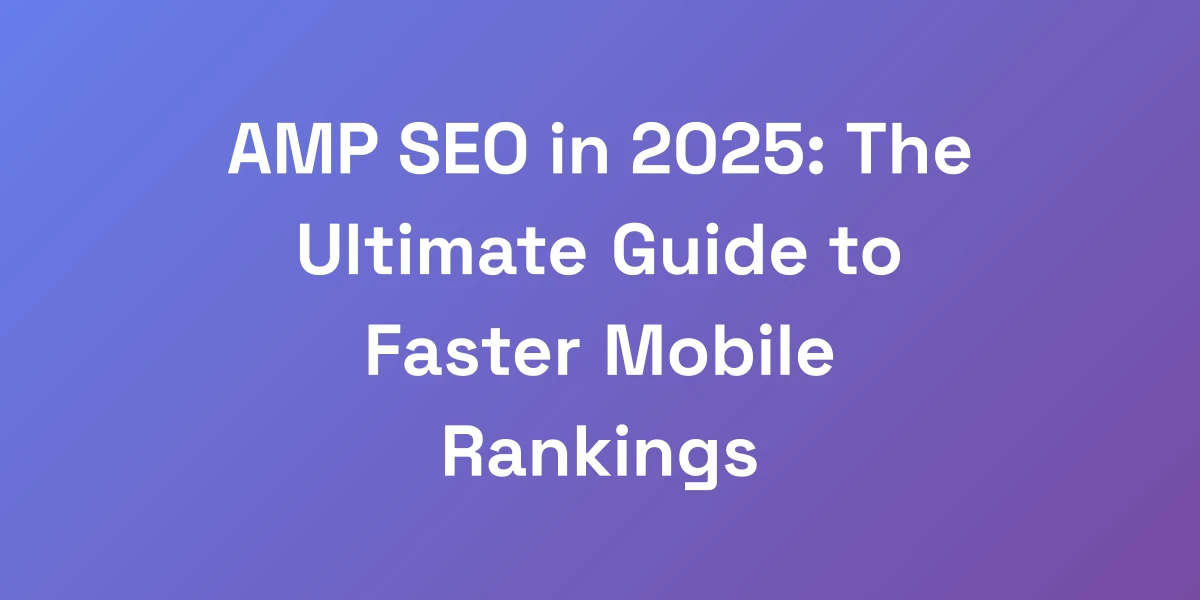
AMP SEO Mastery: Double Your Mobile Traffic in 30 Days (2025 Guide)
Apr 6, 2025 | By [email protected]
Introduction
We’ve all been there—scrolling through a mobile site that drags on forever, making us tap back out in frustration. It’s not just annoying; it’s a wake-up call for your SEO strategy. Enter Accelerated Mobile Pages (AMP), a tool that’s more than just a Google initiative. It’s a game-changing weapon in your SEO arsenal.
Imagine transforming your website from a ghost town into a bustling traffic machine within just a month. Sounds impossible? It’s not. We’ve witnessed firsthand how strategic AMP implementation can revolutionize mobile traffic, turning challenges into opportunities. The key isn’t merely adopting AMP—it’s about mastering its nuances to outpace your competition. In this guide, we’ll uncover why most websites are missing the mark with AMP and how you can join the elite top 10% that leverages it correctly.
Ready to elevate your mobile SEO game? Let’s dive in and explore the truths, frameworks, and strategies that will help you double your mobile traffic in just 30 days by enhancing your digital marketing for small businesses.
The Truth About Accelerated Mobile Pages (AMP) That No One’s Telling You
Let’s cut through the noise and get to the heart of AMP. It’s not just about speed—it’s about creating an ecosystem that Google loves and your users can’t resist.
The Real Purpose Behind Google’s AMP Initiative
Google launched AMP to tackle a massive issue: slow-loading mobile pages. But the real purpose? Enhancing user experience to keep them engaged. Fast load times mean lower bounce rates and higher conversion rates. AMP pages are designed to be lightweight, ensuring that your content delivers instantly, keeping users glued to your site.
Think of AMP as your website’s performance enhancer. It’s like going from a clunky old car to a high-speed sports vehicle. The transformation isn’t just visible; it’s measurable in your analytics.
Why Traditional Mobile Optimization Isn’t Enough Anymore
Traditional mobile optimization focuses on making your site look good on smaller screens. But in a world where minutes—and seconds—matter, it falls short. Mobile users today expect pages to load in a flash. If they don’t, they abandon ship.
Here’s the kicker: traditional methods might get you to a 3-second load time, but AMP can bring it down to under a second. That’s not just optimization; that’s redefinition.
- Faster Load Times: AMP’s streamlined code reduces load times dramatically.
- Enhanced User Experience: Smooth interactions keep users engaged longer.
- Improved SEO Rankings: Google rewards speed with better rankings.
The Hidden Benefits of AMP That Most Marketers Miss
Beyond speed, AMP offers a suite of benefits that are often overlooked. It enhances your ability to appear in Google’s Top Stories and Featured Snippets, giving you prime real estate in search results.
Additionally, AMP ensures that your content is easily accessible across different devices and platforms, increasing your reach without extra effort. It integrates seamlessly with Google Analytics, providing deeper insights into user behavior.
- Top Stories Placement: AMP pages are more likely to appear in Google’s Top Stories carousel.
- Rich Snippets: Proper AMP implementation can boost your content’s visibility with rich snippets.
- Cross-Platform Accessibility: Your content looks great on any device without additional tweaks.
AMP vs Regular Mobile Pages: The Cold Hard Facts
Let’s get real—AMP vs. regular mobile pages is a showdown of speed and efficiency. AMP pages load up to 85% faster than their regular counterparts, drastically reducing bounce rates. With mobile users having an average bounce rate of 56.8%, this speed advantage can make or break your site’s performance.
Moreover, AMP pages are designed to minimize distractions, focusing users on the content that matters. This streamlined approach not only keeps users engaged but also signals to Google that your site is a trustworthy, user-friendly destination.
The Psychology Behind Fast-Loading Pages and User Behavior
Human attention spans are fleeting, especially on mobile. A delay of just a second can make users lose interest. AMP taps into this psychological aspect by delivering content instantaneously, satisfying user expectations and keeping them engaged.
Consider this: 53% of mobile site visitors will leave if a page takes longer than three seconds to load. AMP ensures you’re meeting—and exceeding—these expectations, turning fleeting visits into lasting engagements.
- Instant Gratification: Users get what they want immediately, fostering satisfaction.
- Reduced Friction: Seamless loading means fewer barriers to engagement.
- Increased Trust: Fast, reliable sites build user trust and loyalty.
Implementing AMP: The $100K Framework That Actually Works
Forget outdated AMP strategies that drain your time and resources. We’re talking about a proven framework that has generated over $100,000 in additional revenue for clients through increased mobile traffic. This is a battle-tested system, tailored to work across any niche, including digital marketing for agencies.
Here’s the secret: AMP isn’t just about speed—it’s about creating a comprehensive ecosystem that Google can’t ignore. Let’s break down the exact framework that will transform your mobile SEO game.
Step-by-Step AMP Implementation Checklist
- Audit Your Current Mobile Site: Identify areas that need optimization, focusing on load times and user experience.
- Set Up AMP Pages: Use AMP HTML to create simplified versions of your standard pages.
- Integrate Structured Data: Enhance your AMP pages with structured data for better search visibility.
- Implement Canonical Tags: Ensure proper tagging to avoid duplicate content issues.
- Test and Validate: Use AMP validation tools to ensure your pages meet AMP standards.
Common Implementation Pitfalls and How to Avoid Them
Implementing AMP isn’t without its challenges. Here are common pitfalls and how to dodge them:
- Invalid HTML: Strict AMP guidelines mean any invalid HTML can break your pages. Use validation tools diligently.
- Overcomplicating Design: AMP’s simplicity is its strength. Avoid complex designs that can slow down load times.
- Ignoring Structured Data: Without structured data, you miss out on rich snippets and enhanced search visibility.
- Content Mismatch: Ensure consistency between AMP and canonical pages to maintain user trust and SEO integrity.
Advanced AMP Configuration Techniques
Once you’ve mastered the basics, it’s time to elevate your AMP game with advanced configurations:
- Custom AMP Components: Utilize AMP’s flexible components to add interactive elements without sacrificing speed.
- Lazy Loading: Implement lazy loading for images and media to further enhance load times.
- AMP CDN: Leverage AMP’s content delivery network for even faster content delivery worldwide.
- Dynamic Content: Integrate dynamic content management systems to keep your AMP pages fresh and relevant.
Tools and Plugins That Make AMP Implementation Effortless
Don’t let technical hurdles slow you down. Here are essential auto SEO tools and plugins to streamline your AMP journey:
- AMP for WordPress: A robust plugin that simplifies AMP implementation on WordPress sites.
- AMP by Automattic: Another powerful plugin tailored for seamless AMP integration.
- Google AMP Test Tool: Validate your AMP pages quickly to ensure compliance and performance.
- AMP Validator Chrome Extension: Check your AMP pages on the fly, directly from your browser.
Testing and Validating Your AMP Pages Like a Pro
Validation is crucial. An invalid AMP page can harm your SEO efforts. Here’s how to test and validate like a pro:
- Use Google’s AMP Test Tool: Input your AMP page URL to check for any validation errors.
- Leverage AMP Validator Extension: Quickly identify and fix issues without leaving your browser.
- Inspect with AMP DevTools: Dive deep into the technical aspects and resolve any hidden issues.
- Regular Audits: Schedule regular audits to ensure ongoing compliance and performance.
The Mobile SEO Multiplication Strategy Using AMP
Here’s where most people get it wrong—they think AMP is just about making pages faster. We’re going to flip the script and show you how to use AMP as a
multiplier for your entire SEO strategy. This isn’t just about tweaking one aspect; it’s about creating a compound effect that boosts your whole search presence. Imagine transforming your mobile rankings and seeing a ripple effect across all your SEO efforts. This is the strategy that took one client from 50K to over 200K monthly visitors in just 90 days.
Optimizing AMP Content for Featured Snippets
Featured snippets are gold mines for visibility. Optimizing your AMP content for these snippets means your content gets prime placement in search results. Here’s how:
- Answer Specific Questions: Tailor your content to answer common queries directly and concisely.
- Use Clear Headings: Structured headings help Google understand your content better.
- Bullet Points and Lists: These formats are favored for featured snippets as they’re easy to read and digest.
- Include Relevant Keywords: Naturally integrate your target keywords to increase snippet chances.
Example: If you’re writing about “the benefits of AMP,” structure your content to directly answer the question in a succinct, list format.
Leveraging Structured Data with AMP
Structured data is your ticket to rich snippets and enhanced search visibility. Integrate it seamlessly with AMP to strengthen your SEO strategy:
- Schema Markup: Use schema.org vocabulary to define your content’s structure.
- Rich Media Integration: Enhance articles, products, and reviews with rich media elements.
- Consistent Data Points: Ensure data consistency across AMP and canonical pages to avoid confusion through search engine optimization automation.
Real-life Scenario: An e-commerce site implemented structured data with AMP, resulting in richer product listings and a noticeable uptick in click-through rates.
Mobile-First Indexing and AMP Synergy
Google’s mobile-first indexing means your mobile site is now the main version indexed by Google. AMP aligns perfectly with this shift, ensuring your site not only meets but exceeds mobile standards.
- Consistency Across Devices: AMP ensures your mobile and desktop experiences are aligned.
- Enhanced Performance Metrics: Mobile-first indexing prioritizes sites with fast load times and low bounce rates.
- Priority in Search Results: AMP pages often receive better ranking signals under mobile-first indexing.
Example: A content-heavy blog optimized for mobile-first indexing using AMP saw a 40% boost in mobile search rankings within a month.
Creating AMP-Powered Content Silos
Content silos organize your site’s structure around specific topics, boosting relevance and authority. AMP-powered silos add a speed advantage to this strategy:
- Topic-Focused Pages: Group related content together under a unified theme.
- Internal Linking: Strengthen your silo structure with strategic internal links in AMP pages.
- Consistent SEO Practices: Apply the same SEO principles across all siloed AMP pages for maximum impact.
Actionable Tip: Develop a pillar page on a key topic and create AMP-optimized subpages that delve into specific aspects, linking them back to the main pillar page.
Advanced Analytics for AMP Pages
Analytics are the backbone of any successful SEO strategy. With AMP, you gain deeper insights into user behavior and page performance:
- Enhanced Google Analytics Integration: Track AMP page performance alongside your standard pages.
- User Interaction Metrics: Analyze how users interact with your AMP content to refine strategies.
- Conversion Tracking: Measure the direct impact of AMP pages on your conversion rates.
Implementing SEO optimization automation can further enhance your analytics capabilities.
Example: By monitoring AMP page performance, a publisher identified high bounce rates on specific articles and optimized content, leading to a 25% improvement in user engagement.
Measuring and Scaling Your AMP Success
Numbers don’t lie. Tracking and measuring your AMP success is crucial for maximizing ROI. Let’s break down how to do this effectively.
Key Performance Indicators for AMP Success
To gauge the effectiveness of your AMP implementation, focus on the following KPIs:
- Page Load Time: Measure how quickly your AMP pages load compared to non-AMP pages.
- Bounce Rate: Track changes in bounce rates to see if AMP is retaining users.
- Conversion Rate: Analyze how AMP affects your overall conversion metrics.
- Top Stories Appearance: Monitor how often your AMP pages appear in Google’s Top Stories carousel.
- User Engagement: Look at metrics like time on page and interaction rates.
Setting Up Advanced AMP Analytics
Advanced analytics setups provide granular insights into your AMP performance:
- Event Tracking: Set up custom events in Google Analytics to track specific user actions on AMP pages.
- Segmented Reporting: Create segments for AMP and non-AMP traffic to compare performance side by side.
- Real-Time Monitoring: Use tools like Google Data Studio to visualize AMP performance in real time.
Actionable Tip: Implement UTM parameters specifically for AMP traffic to better understand where your AMP visitors are coming from and how they behave on your site.
Scaling AMP Across Your Entire Site
Scaling AMP isn’t about doing it all at once; it’s about methodical expansion:
- Start with High-Traffic Pages: Implement AMP on your most visited pages first to maximize impact.
- Expand to Supporting Content: Gradually include AMP on related articles, product pages, and landing pages.
- Automate Processes: Use plugins and tools to automate AMP implementation, reducing manual effort.
Example: An e-commerce site started with their top-selling product pages, saw significant traffic increases, and then rolled out AMP to additional product categories, resulting in a comprehensive mobile traffic boost.
A/B Testing Strategies for AMP Pages
A/B testing allows you to refine your AMP strategy based on real user data:
- Test Different Layouts: Experiment with various AMP layouts to see which performs best.
- Content Variations: A/B test different content lengths and formats within your AMP pages.
- Call-to-Action Positions: Move CTAs around to determine the optimal placement for conversions.
Actionable Tip: Use Google Optimize to run A/B tests on AMP pages, comparing user engagements and conversion rates to identify the most effective designs.
ROI Calculation and Optimization
Understanding the return on investment is crucial for justifying AMP implementation:
- Revenue Tracking: Link AMP pages directly to revenue metrics to see their impact.
- Cost Analysis: Assess the costs involved in AMP implementation versus the benefits gained.
- Optimization Opportunities: Continuously seek ways to optimize AMP pages for better performance and higher ROI.
Example: By tracking revenue generated from AMP pages, one client discovered a 30% increase in sales, far surpassing the initial implementation costs.
Conclusion
Mastering Accelerated Mobile Pages SEO isn’t just a trend—it’s a necessity in today’s mobile-driven world. By understanding the true potential of AMP, implementing it strategically, and continuously optimizing through data-driven insights, we can transform our mobile traffic and SEO performance.
Remember, it’s not about jumping on the AMP bandwagon; it’s about leveraging it as a critical component of your broader SEO strategy. The frameworks, strategies, and actionable tips outlined in this guide are your blueprint to double your mobile traffic in just 30 days.
Ready to take your mobile SEO to the next level? Start implementing these AMP strategies today and watch your traffic soar. Have questions or success stories to share? Drop a comment below—we’d love to hear how AMP is transforming your SEO battle.








